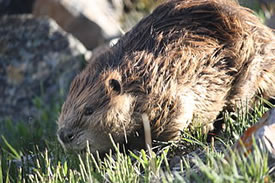Be on the lookout for these eight common invasive species
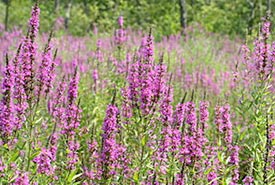
Purple loosestrife (Photo by Liz West, Wikimedia Commons)
Spending all this time at home has helped me realize something: I’ve been in denial about the invasive plants growing around my home. The little patch of garlic mustard by our front steps, which I’m sure came from seeds on my boots after doing field work, has grown and spread. There’s also lot more buckthorn growing in the small pine and spruce plantation beside our house than I’d like to admit.
We can all play a role in helping to manage and track the spread of invasive species. As the weather warms and buds reappear on trees, invasive species that seem to have hidden under the radar are also springing back up. Spring is a great time to audit your yard for any invasive species.
Related content:
Globally, invasive species have been identified as the number two threat to nature, just behind habitat loss. The impact of invasive species can result in economic losses for people and communities. For example, Japanese knotweed can lower our property values, and emerald ash borer is a major pest in our forests. Invasive species that damage the agricultural and forestry industries results in an estimated $7.5 billion of lost revenue annually.
Invasive species often have few predators or diseases to keep their numbers in check. Once they’ve gained a foothold, they can outcompete native species and significantly alter their habitats.
Below are eight invasive species to check your property for. If you can, learn about how to control them on your property. They can all move from backyards to natural areas. You can also report them on apps like iNaturalist and help scientists better understand their distribution and spread.
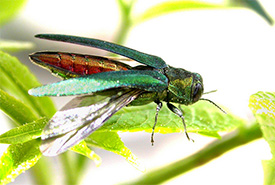
Emerald ash borer adult (Photo by by U.S. Department of Agriculture)
This non-native invasive beetle has decimated tens of millions of ash trees and continues to spread rapidly. It can quickly kill large areas of ash trees, impacting forests, areas along streams and rivers, and urban forests. It has spread to some areas when people have moved firewood that has been cut from infected ash trees.
Where it’s found in Canada: Manitoba, Ontario, Quebec, Nova Scotia, New Brunswick.
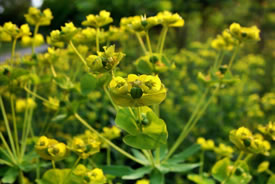
Leafy spurge (Photo by Ed L/pawpaw67)
This plant has yellow-greenish flowers, and its leaves and stems have a white, milky sap. It probably came to Canada in grain seeds from Europe. It spreads quickly in open areas and threatens habitats, such as tall grass prairie in Manitoba. In Saskatchewan, beetles have been introduced to the area as a biological control.
Where it’s found in Canada: Yukon, BC, Alberta, Saskatchewan, Manitoba, Ontario, Quebec, New Brunswick, Nova Scotia, PEI.
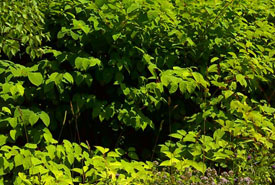
Japanese knotweed (Photo by NCC)
Resembling bamboo and likely introduced as a garden plant, Japanese knotweed can form dense thickets and outcompete native vegetation. It’s particularly a problem in Atlantic Canada, where it takes over the edges of creeks and lakes. It’s been identified by the International Union for Conservation of Nature as one of the world’s worst invading species.
Where it’s found in Canada: BC, Alberta, Ontario, Manitoba, Ontario, Quebec, New Brunswick, Nova Scotia, PEI, Newfoundland and Labrador.
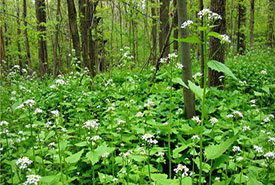
Invasive garlic mustard can take over forests, harming native understory species (Photo by NCC)
Native to Europe, this green-leafed herb with white flowers was first recorded in New York in 1868 and may have been brought over as a medicinal plant. It spreads through forests and displaces native wildflowers and tree seedlings. Each plant produces thousands of tiny, black seeds that are viable in soil for many years.
Where it’s found in Canada: BC, Alberta, Ontario, Quebec, New Brunswick, Nova Scotia, PEI.
Buckthorn
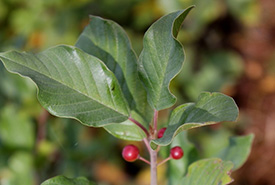
Glossy buckthorn (photo by Calin Darabus)
There are two kinds of this shrub — glossy false buckthorn and common — both of which have berry-like fruits that produce large number of seeds. They were introduced in the late 1800s primarily to create windbreaks along farm fields. Unfortunately, the plant spreads quickly and prevents native trees and shrubs from regenerating. Common buckthorn is also the primary host for the non-native soybean aphid; a serious threat to farmers.
Where it’s found in Canada: Alberta (Common only), Saskatchewan (European only), Manitoba, Ontario, Quebec, New Brunswick, Nova Scotia, PEI.
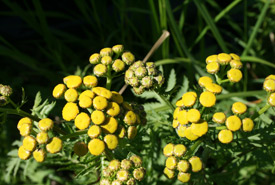
Common tansy (Photo by NCC)
This plant with yellow, button-like flowers can grow as tall as 1.5 metres. It was introduced to North America from Europe in the 1600s as a horticultural and medicinal plant. It impacts stream banks and native grasslands and outcompetes native plants. It also produces a toxic compound that can impact cattle and wildlife.
Where it’s found in Canada: Everywhere except Nunavut.
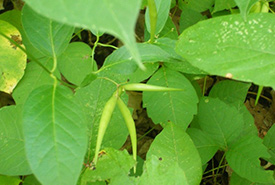
Dog-strangling vine seed pods (Photo by NCC)
This vine can grow up to two metres long and take over dense thickets or grow on other plants. Monarchs have been known to lay eggs on the plant, but the larvae do not survive. The plant invades forests, stream banks, grasslands and alvar habitats (limestone plain). A moth from the Ukraine that feeds on the vine has been approved for release in North America as a biological control.
Where it’s found in Canada: BC, Ontario, Quebec.

Purple loosestrife (Photo by Liz West, Wikimedia Commons)
This plant is listed as a noxious weed in many provinces but is still sometimes sold as an ornamental plant. But before adding it to your garden, you should know it crowds out most native vegetation and creates near-monocultures. It has also been identified by the International Union for Conservation of Nature as one of the world’s worst invading species, because a single purple loosestrife plant can produce over two million seeds each year.
Where it’s found in Canada: BC, Alberta, Saskatchewan, Manitoba, Ontario, Quebec, New Brunswick, Nova Scotia, PEI, Newfoundland and Labrador.
Check our invasive species gallery for other plants that might be lurking in your yard!




